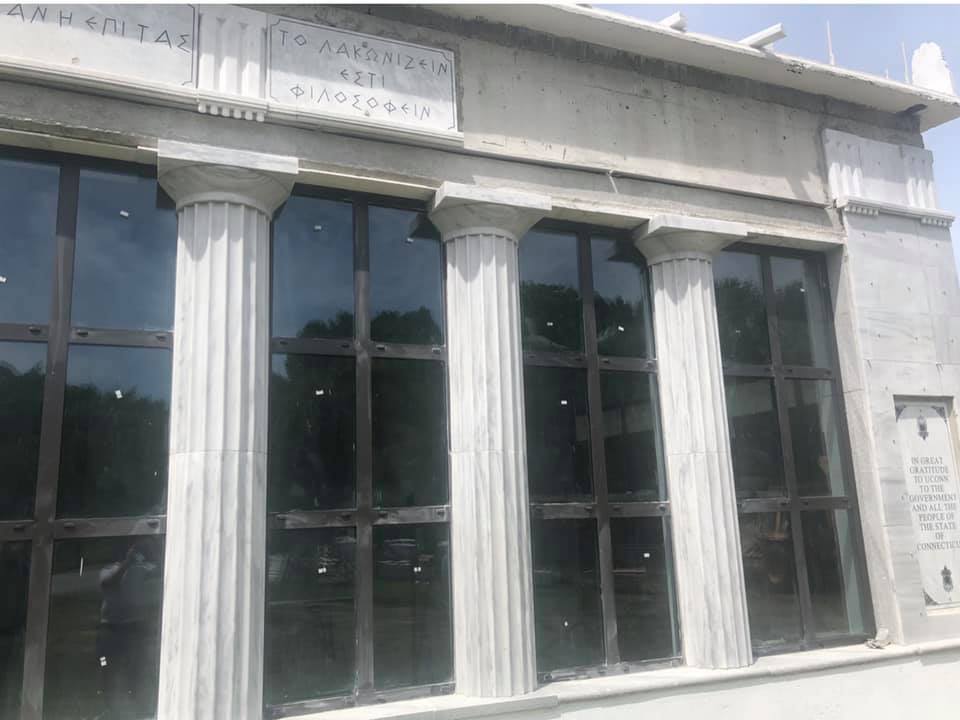
The University of Connecticut will soon open a new Sparta museum on its campus which will be entirely dedicated to the ancient Greek city-state.
The news that the University would construct a museum on the Ancient Greek city state was made public after a meeting held two years ago between Ilias Tomazos, the head of the University’s department of Greek studies, and Greece’s Culture Minister Lina Mendoni.
Tomazos also serves as the head of the the Paideia Center for Hellenic Studies in Connecticut.

The new Spartan museum will focus its interest on artifacts and events dating from the prehistoric era of the broader Laconia region all the way to Byzantine times.
The museum is located in the area of the campus where an Orthodox Christian chapel and a Greek theater are already located, along with a library and an educational center.
The stunning, all-marble Classical-style theatre, which was recently completed, seats over 700 spectators.
The nearby Three Hierarchs Byzantine Chapel was opened in 1995. The Greek Orthodox church is open during the academic year and during major holidays.
The Macedonia Educational Building, also in the same area of the Storrs campus, was opened in 1997. It includes multiple classrooms, several offices, student meeting rooms, a community hall, a library, and an exhibit hall.
Ilias Katsos, a prominent member of the New York are Greek diaspora, donated funds for four of its marble metopes which are currently being installed. Volunteers such as himself, along with Christo Bakes and Nikos Skroubelos, whose families originated from the Epanou Riza area of the Laconian Northern Taygetos also helped make the gleaming new Museum and its facilities a reality.

Additionally, a new statue of Spartan leader Leonidas, as well as a sculpture depicting the battle of Thermopylae, will be placed there in the future.
The majority of the expenses for the construction of this project were covered through donations.
The Greek Culture Ministry, which declared its intention to assist with the Sparta project, also pledged to offer materials that were used in its creation. Mendoni said the Culture Ministry would support the initiative through the provision of sculpture copies, photographic material, and digital media.
The Paideia Center’s Tomazos also informed Mendoni about the cultural programs to be offered at UConn and invited the minister to the opening of the “Alexander the Great” open-air theater in October.
Life in Sparta harsh, unforgiving, under total state control
The Spartans were warriors, disciplined and strong, and always ready to die for their homeland. Hence the word “Spartan,” which we use today, meaning someone who lives an austere life, indifferent to pleasures and luxuries.
Life in Sparta was one of simplicity and self-denial. Children were children of the state more than of their parents. They were raised to be soldiers, loyal to the state, strong and self-disciplined.
When a Spartan baby was born, soldiers came to the house and examined it carefully to determine its strength. They bathed the baby in wine rather than water, to see its reaction.
If a baby was weak, the Spartans would throw it off a cliff (the Kaiadas) or take it away to become a slave (helot).
The city-state — not parents — decided the fate of children, and nurses, who provided their primary care, did not coddle the babies at all.
A mother’s softening influence was considered detrimental to boys’ education, so a Spartan boy would be taken from his mother at the age of seven and soldiers would put him in a dormitory with other boys to train them to become soldiers.
The boys went through harsh physical training and deprivation to make them strong. They marched without shoes and went without food.
Boys in Sparta learned the art of battle, to endure pain and survive through their wits. The older boys willingly participated in beating up the younger boys to make them tough.
Once they turned 20, young Spartan men had to pass a rigorous test to graduate and become full citizens, as only worthy soldiers gained the aristocratic citizenship.
If they failed their tests, they never became citizens but became perioeci, the middle class.
If the young men passed, they continued to live in the barracks and train as soldiers and were also required to marry — in order to produce new young Spartans.
The state gave them a piece of land which was farmed by slaves. The income supported them as full-time soldiers.
At the age of 30, they were allowed to live with their families but they continued to train until the age of 60, when they retired from military service.
See all the latest news from Greece and the world at Greekreporter.com. Contact our newsroom to report an update or send your story, photos and videos. Follow GR on Google News and subscribe here to our daily email!



